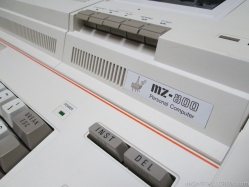
Autopsy:
from Old-Computers.com:
The sharp MZ 800 was the successor of the MZ 780. It was partially compatible with the MZ 700 series and the old MZ 80K series as well.
It was sold under three reference numbers:
- MZ-811 without tape drive.
- MZ-821 with built-in 1200-baud tape drive.
- MZ-831 with tape drive and built-in 4-colour printer-plotter.
The Tape drive could be substituted for a Quick-disk drive unit. The Quick-Disc was a small 2.8-inch disk with sequential access.
Like the MZ 700, there was no language in ROM, it had to be loaded from tape, quick disk or floppy disk. The ROM only contained boot code, OS calls and special code to allow the user to use the 64 KB RAM as a virtual disk.
A single or double 5.25″ disk drive could be connected to the MZ 800. It then worked under a special version of CP/M called P-CP/M. Some great products like Wordstar, dBase II and Multiplan were adapted to it. Under CP/M, it was possible to read multiple disk formats from the 360 KB (Sharp format) to the 720 KB (CP/M IBM PC format).
The MZ 800 was sold in Japan under the name SHARP MZ 1500. The MZ 1500 had the same characteristics except its black case, a built-in Quick-Disc drive and a slighty different graphic video management.
source: old-computers.com
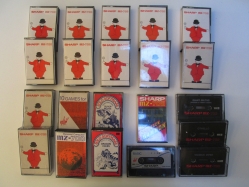
Autopsy:
This is a rare collection of software for MZ-80 and Mz-700 Sharp Personal Home Computers.
Software titles:
Space Invaders, Suicide run and Space Fighters (Corsa suicida – Guerre Stellari), Exploding Atoms, Trap of Doom and Cave Adventure, American Bowling, Couter Reverse and Caterpillar Craws, Le Mans Turbo, Cribbage, Gate Crasher and Jungle Jiks, Rescue Plane, Wizard Castle, Cosmic Invasion and Bomb Run, Battle Game, Super Packman, Sinus Star, Moving Searcher, Painful Man, Man-Hunt, Land Escape, Round Shoot, Send 1, Snake & Snake, Giant Maths, Othello, Vicious Viper, Dragon Caves (Il drago degli Abissi), Super-Mouse (Topolino), Backgammon and Basic v1.0a & Applications.
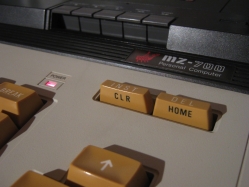
Autopsy:
from Old-Computers Museum homepage:
The Sharp MZ 700 series replaced the aging MZ 80 (MZ 80K, MZ 80A and MZ 80B) series. Moreover, the MZ 700 was compatible with the MZ 80K and MZ 80A. The MZ 700 series is composed of four machines: the first three models were launched in 1983 (November 1982 in Japan) and the last one was launched in late 1985 (in fact, this one is the “ancestor” of the MZ 800): MZ 711 was the “naked” model (without any peripheral).
Model description:
- MZ 721, has an integrated tape recorder
- MZ 731, has built-in plotter and tape recorder).
- MZ 780 which was actually a MZ 731 with a 80 columns card, a floppy disk drive and a Centronics port. It worked under CP/M.
There was no language in ROM (the ROM size is only 2 KB, it is just used for boot and OS calls), it has to be loaded from tape. So there was a lot of languages adapted for this machine (more than five versions of BASIC, assemblers, Pascal, Lisp, C, Fortran, Comal, Forth, & others). The games were a bit poor because of the low resolution (which was actually graphical characters), but there were 512 graphic characters in ROM, which can be used to offset it (sort of).
Later this model it will be replaced with the MZ 800.
source: old-computers.com wikipedia
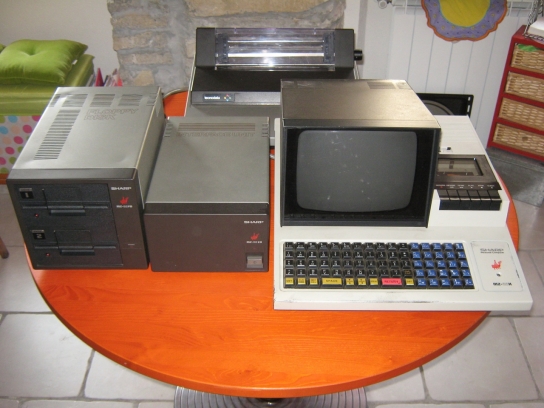
You can see the individual devices by clicking the link below.
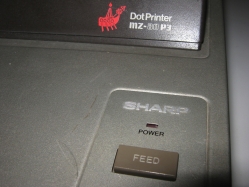
Autopsy:
I have removed two polyester capacitors (filter) before they explode.
This is a dot matrix printer produced by Sharp for Personal microcomputer System MZ-80 Series. The Sharp MZ-80 P3 must be connected to the Sharp MZ-80 I/O (Interface Unit) to be utilized. This printer has been built by Epson and later rebranded by Sharp.
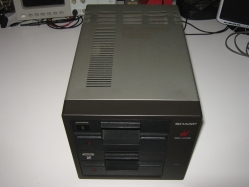
Autopsy:
I have removed two polyester capacitors (filter) before they explode.
Floppy Disk Drive for Personal microcomputer System MZ-80 Series. Each floppy disk can contain 143k of data for a total of 286K. The Floppy Disk Drive must be connected to the Sharp MZ-80 I/O (Interface Unit) to be utilized.
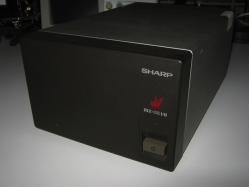
Autopsy:
I have removed two polyester capacitor (filter) that are exploded after a few seconds.
This is a I/O Extension device to connect bus-line signals being output from MZ-80K to peripheral units such as dot printer, floppy disk, colour display and so on.
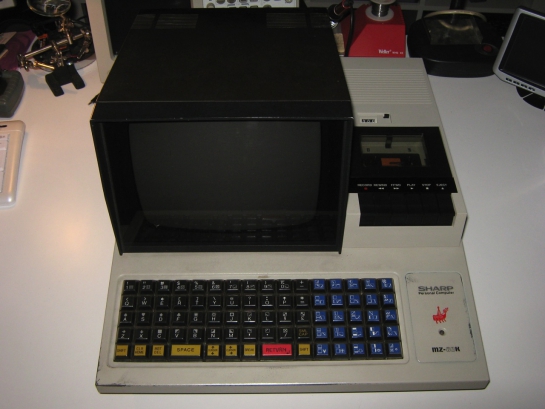
Autopsy:
from Wikipedia:
The Sharp MZ is a series of personal computers sold in Japan and Europe (particularly Germany and Great Britain) by Sharp beginning in 1978.
Although commonly believed to stand for “Microcomputer Z80″, the term MZ actually has its roots in the MZ-40K, a home computer kit produced by Sharp in 1978 which was based on Fujitsu’s 4-bit MB8843 processor and provided a simple hexadecimal keypad for input. This was soon followed by the MZ-80K, K2, C, and K2E, all of which were based on 8-bit LH0080A Sharp CPU (compatible to Zilog Z80A) with an alphanumeric keyboard.
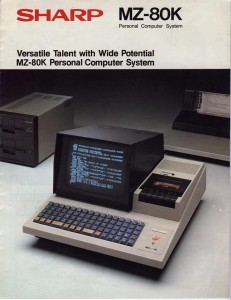 The Sharp MZ80K was one of the popular early consumer-level microcomputers, with an architecture based on the Zilog Z80 8-bit microprocessor. It was introduced into Europe in 1979. The machine had 48KB of RAM, 32KB of which was available for user programs (the actual figure was dependent on the memory configuration and the system languages being used).
The Sharp MZ80K was one of the popular early consumer-level microcomputers, with an architecture based on the Zilog Z80 8-bit microprocessor. It was introduced into Europe in 1979. The machine had 48KB of RAM, 32KB of which was available for user programs (the actual figure was dependent on the memory configuration and the system languages being used).
It could run a variety of high-level languages including BASIC, Pascal and FORTRAN, which had to be loaded into RAM before any programming could be undertaken. It could also be programmed directly in assembly code or machine code. The machine had an inbuilt monochrome display and a cassette tape drive. The display, keyboard and cassette drive lifted on hinges to expose the motherboard and circuitry underneath. Graphics capability was primitive, with only preset shapes and icons being available and no native hi-res capability.
This was not unusual for a late-1970s vintage microcomputer. The main drawback, however, of the MZ-80K was the non-standard keyboard, which was difficult to use.
The MZ-80K sold well in Europe despite its high price (it retailed at over £500 in 1980), and a large range of software was available, including some Japanese arcade games. It was superseded in 1982 by the MZ-80A machine.
source: wikipedia















































































































Recent Comments